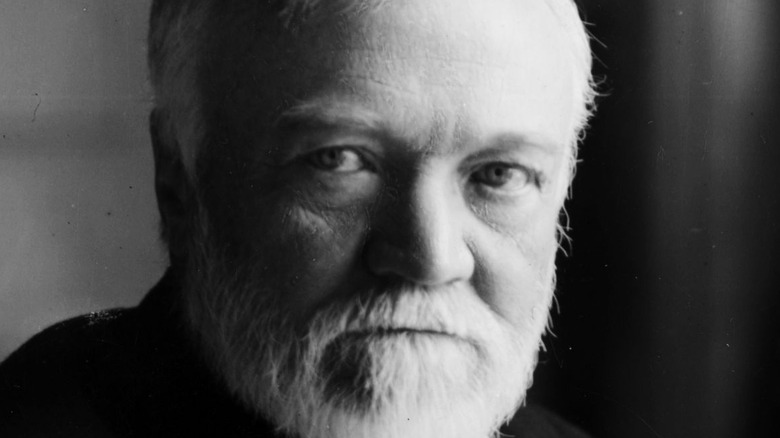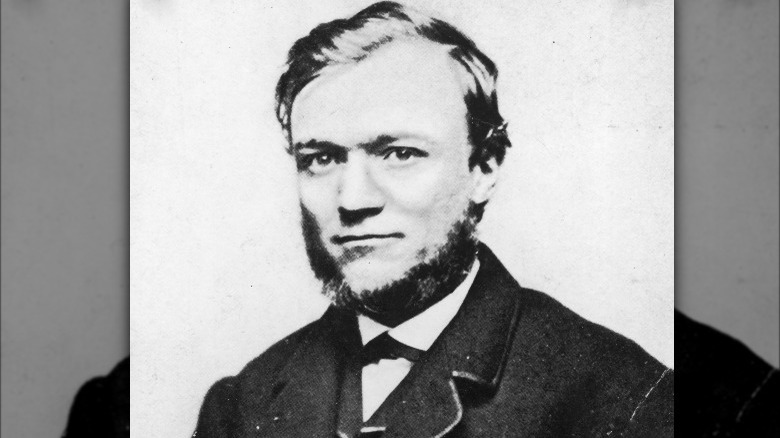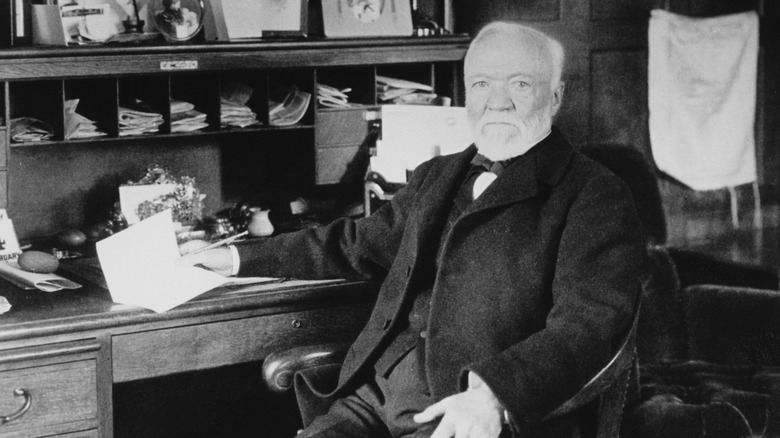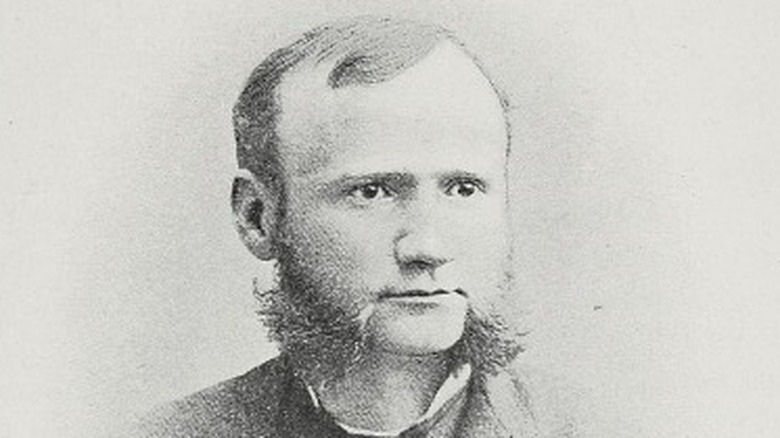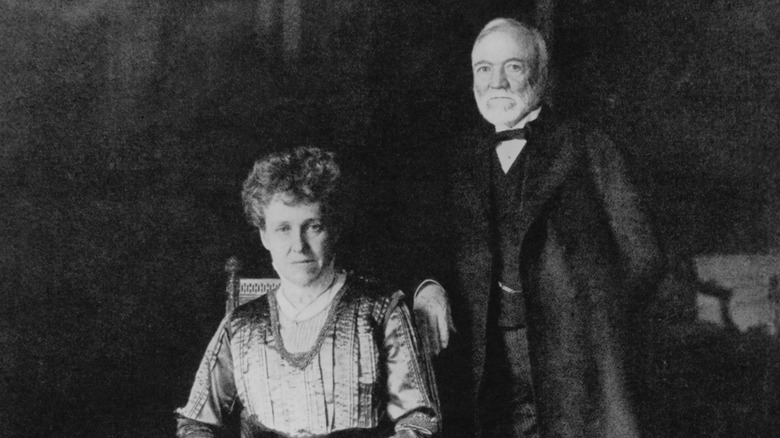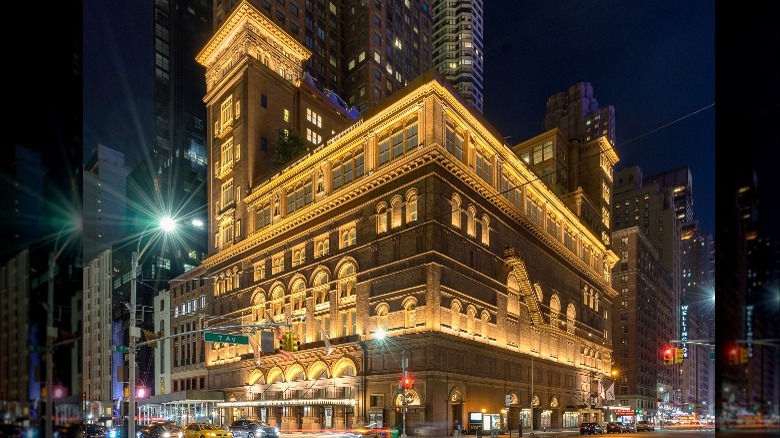Here's What Happened To Andrew Carnegie's Money After He Died
From the end of the Civil War in 1865 through the turn of the 20th century, America experienced a period of rapid industrial and economic growth now known as the Gilded Age (via History). This made the leaders of steel and railroad corporations from that era richer than many from that time could ever imagine. One such example is Andrew Carnegie, a Scottish-American immigrant who made his money in the steel industry, among other endeavors. In the opinion of some (via another History posting), the unprecedented wealth generated by recent tech booms for CEOs such as Jeff Bezos from Amazon and Elon Musk from Tesla has put America into the Gilded Age 2.0.
Which raises the question, what should someone that rich do with their money after they die? Learning what Andrew Carnegie chose to do with his wealth when he died, and even while he was still alive, is instructive. Modern tech and financial billionaires like Bill and Melinda Gates, Warren Buffett, and Bezos' ex-wife, MacKenzie Scott, seem to have followed Carnegie's lead, each pledging to give away at least half of their considerable fortunes while they're alive, according to CNBC. Carnegie's noted philanthropy, though, went to specific institutions, and even though much of his wealth is now gone, that legacy lives on today.
How Andrew Carnegie made his money
Much of what Andrew Carnegie chose to do with his money was likely influenced by the fact he was born poor in Scotland in 1835, according to History. The man who would one day become among the richest men of his generation began working in textile mills and in the telegraph industry at the young age of 13. Largely self-educated, with books from free libraries in Scotland, by the 1870s, Carnegie had come to America and founded a steel plant. From there, Carnegie's company would grow to become the Carnegie Steel Company, among the largest and most successful of its type from that time.
That was just one of the many entrepreneurial ventures that Carnegie had a hand in. By 1901, Carnegie sold his steel company to J.P. Morgan for $480 million, or roughly $13.3 billion in today's money (via Dollar Times). From there, all that remained for Carnegie was to live a life of luxury, alongside his wife Louise Whitfield Carnegie and Carnegie's only child, named Margaret. A man of Carnegie's considerable wealth would most likely leave most of his fortune to his family. Carnegie had other plans.
'The man who dies thus rich dies disgraced'
As early as 1889, Andrew Carnegie already plans for what to do with his wealth after his death. This wasn't just a personal matter for Carnegie, either. He had strong opinions about how all Gilded Age industrialists should manage their money, and he wrote down these thoughts in an essay titled "The Gospel of Wealth," according to Forbes. (The essay is posted online at the website of The Carnegie Corporation of New York.) In it, Carnegie summed up his personal philosophy about wealth management. "The man who dies thus rich, dies disgraced," Carnegie wrote in the now famous treatise. Wealth of the size and scope Carnegie enjoyed should be largely given away, the famous industrialist said.
These charitable inclinations did not immediately endear Carnegie to the public, who then, like now, might have preferred a tycoon of Carnegie's stature to pay better wages, as U.S. History explains. Similar criticisms are levied against ultra-rich businessmen even today, such as Jeff Bezos (via ABC News). Nor was Carnegie's philanthropic bent shared among other similarly successful industrialists during his time, called "robber barons" because of low pay and questionable business practices designed to minimize competition and maximize personal profit.
Carnegie's brother, Thomas, felt differently
Andrew Carnegie was not the only steel magnate in the Carnegie family. Andrew's brother, Thomas, also made his fortune in the steel industry and was faced with a similar dilemma as far as what to do with his wealth after he died. Unlike Andrew, Thomas (pictured) had a much larger family, with a wife and nine children. Thomas Carnegie also died relatively young, at age 42, as Forbes reports. For his part, Andrew died in his 80s (via History). How Thomas Carnegie chose to manage his wealth shows how different the two brothers' posthumous wealth management strategies were.
Unlike his brother, Thomas chose to leave most of his sizable fortune to his wife and children, as well as the Thomas Carnegie estate, Cumberland Island, just off the coast of Georgia. Each one of Thomas' children were given trust funds of around $10 million, according to Forbes. Eventually, though, that money has largely dried up, and so, too, has the value of Thomas Carnegie's island. Even though some Carnegie descendants still live there, it's now expected the land will be given to the National Park Service when they die. They can no longer afford it.
Not much of Carnegie's wealth went to his wife and child
Perhaps Andrew Carnegie, who lived much longer than Thomas, witnessed how quickly the money was spent that his brother kept in his side of the family. This may have partially contributed to what Andrew would one day decide to do with his own fortune. Carnegie also had one of the world's first known prenuptial agreements. That's not to say that Andrew Carnegie's wife, Louise (pictured, with Andrew), and daughter Margaret were completely forgotten. Carnegie did leave Louise some money, as well as their Manhattan property, and her own personal assets, of course. His daughter Margaret also benefited from a small trust, according to Forbes.
Also included in Andrew Carnegie's remembrance for his immediate family was the Carnegie family vacation home, Skibo Castle in Scotland. Soon enough, though, the money that Carnegie left to his wife and daughter was largely gone, and the Manhattan property was sold. Skibo Castle, now home to the Carnegie Club, was sold to private interests in the 1980s. These days, the Carnegie family is no longer among America's richest families. As one of Carnegie's descendants told Forbes, "Our family has been very much raised with the philosophy that our own individual lives are what we make of them."
Carnegie put his money in institutions
So if not much of Carnegie's sizable fortune was left behind to his immediate family, where did it all go? Even though most of the privately-held Andrew Carnegie wealth is now gone, the wealthy industrialist's legacy lives on in a number of institutions such as Carnegie Hall (above) and a number of Carnegie Libraries all over the U.S. and around the world (via Forbes). In total, Carnegie spent $55 million on roughly 1,600 libraries in the U.S. alone, per the Carnegie Corporation of New York. For this reason, Andrew Carnegie is known as the patron saint of libraries.
There also a number of charitable trusts and foundations that continue to operate under the Carnegie name, both in the U.S. and in the U.K., such as the Carnegie Museums of Pittsburgh, the Carnegie Institution for Science, the Carnegie Foundation for the Advancement of Teaching, and the Carnegie Endowment for International Peace, among many others. The Carnegie Corporation itself was given a $135 million foundation upon which it continues to operate, supporting education and peaceful initiatives all over the world. As can be seen, these are just a few of the ways that Carnegie's influence and fortune still remains with us.
